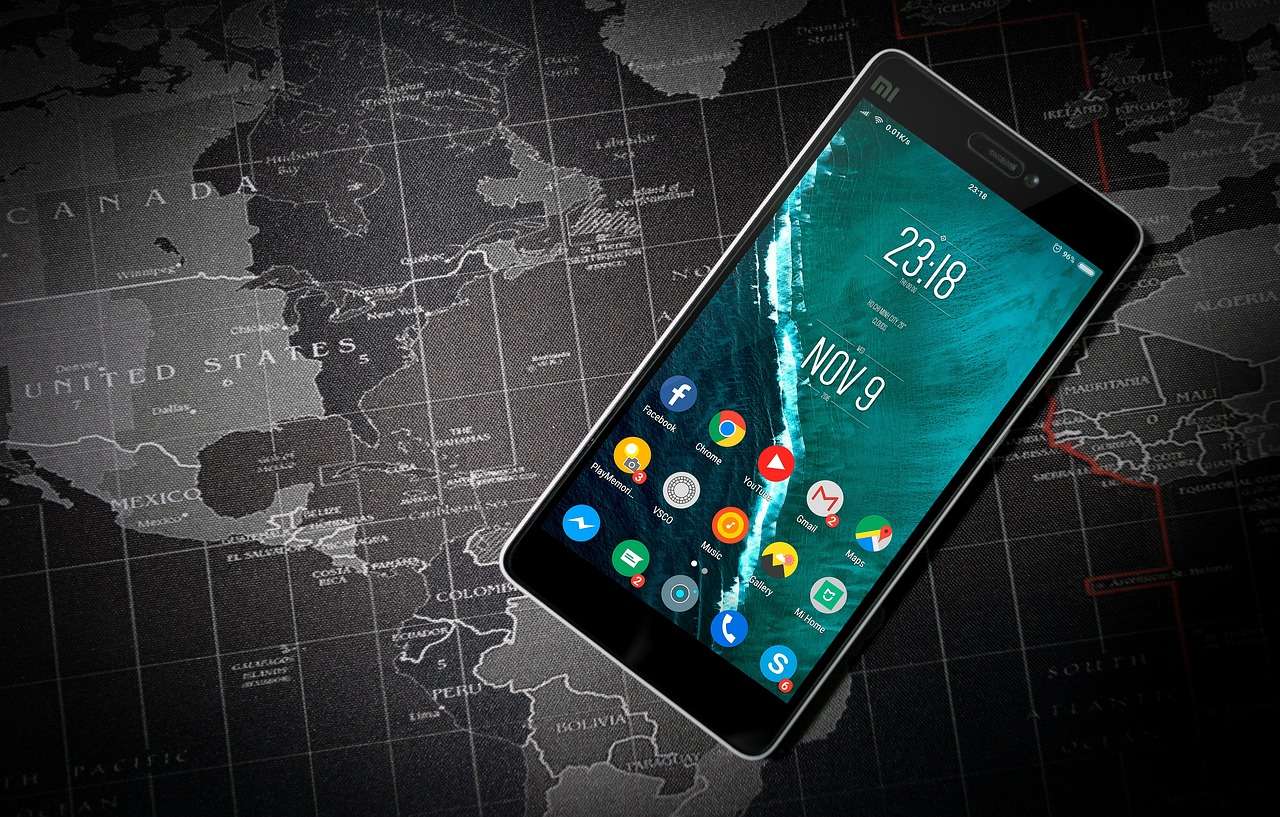Let’s talk about communication without traditional phone lines. With the rapid advancements in technology, people nowadays have numerous ways of staying connected without relying on the traditional telephone systems. This article will explore some of the innovative alternatives to traditional phone lines and discuss the benefits they offer in terms of convenience, cost-effectiveness, and flexibility. From voice-over-internet-protocol (VoIP) services to mobile apps, we will uncover how these modern solutions have revolutionized the way we communicate in today’s digitally-driven world.

Wireless Communication
Wireless communication has revolutionized the way we connect with others, allowing us to communicate without relying on traditional phone lines. In this article, we will explore various methods and technologies that enable wireless communication, from Wi-Fi calling to satellite communication and everything in between.
Wi-Fi Calling
Wi-Fi calling is a feature that allows you to make and receive calls using a Wi-Fi network instead of relying on cellular service. This can be particularly useful in areas with a weak cellular signal or when traveling internationally. By utilizing available Wi-Fi networks, you can place calls and send text messages seamlessly, as if you were using a regular mobile network.
Wi-Fi calling works by using Voice over Internet Protocol (VoIP) technology to transmit your voice over an internet connection. This means that you can make calls from any device that has access to Wi-Fi, such as smartphones, tablets, or even computers. Most modern smartphones come with built-in Wi-Fi calling capabilities, but you may need to configure your device settings or contact your service provider to enable this feature.

Mobile Data
Another popular method of wireless communication is through mobile data. With the increasing availability and speed of cellular networks, we can now access the internet and communicate with others using our smartphones or other mobile devices. Mobile data allows us to send and receive emails, browse the web, use messaging apps, and even make video calls, all without the need for a traditional phone line.
Mobile data works by connecting your mobile device to a cellular network, which then provides you with internet access. This connection is established through a network carrier, such as Verizon, AT&T, or T-Mobile, who transmit data signals to and from your device. The speed and reliability of mobile data can vary depending on your location and the strength of the cellular network, but advancements in technology have greatly improved the overall performance of mobile data networks.
Satellite Communication
Satellite communication offers a unique solution for wireless communication, particularly in remote or rural areas where traditional phone lines may not be available. Satellites orbiting the Earth can transmit and receive signals, providing communication coverage to areas that are otherwise difficult to reach. This technology enables voice calls, internet access, and other communication services in places where terrestrial networks are limited.
There are two primary uses of satellite communication: satellite phones and satellite internet. Satellite phones allow users to make calls and send messages by connecting to satellites in space. These phones are often used in remote locations, disaster-stricken areas, or during outdoor expeditions where traditional cellular networks are unreliable or nonexistent.
Satellite internet, on the other hand, provides high-speed internet access to areas with limited terrestrial infrastructure. This technology utilizes satellites to transmit data signals to and from the user’s location, bypassing the need for cables or phone lines. While satellite internet can be more expensive and slower than traditional broadband options, it offers a viable solution for those unable to access a wired internet connection.

Voice over Internet Protocol (VoIP)
VoIP technology has transformed the way we communicate over the internet, allowing us to make voice and video calls, send instant messages, and much more. Voice over Internet Protocol (VoIP) refers to the transmission of voice data over the internet, converting analog signals into digital packets that can be transmitted using internet protocols.
Overview
VoIP technology is the backbone of various communication services, such as Wi-Fi calling and messaging apps like Skype or WhatsApp. It offers a cost-effective alternative to traditional phone lines, as it utilizes existing internet connections to transmit voice and multimedia data. VoIP has become increasingly popular in both personal and business settings, providing a flexible and scalable communication solution.
Benefits of VoIP
There are numerous benefits to using VoIP for your communication needs. Firstly, it is often more affordable than traditional phone services, as it leverages existing internet connections and eliminates the need for separate phone lines. This can be particularly advantageous for businesses that need to make frequent long-distance or international calls.
VoIP also offers advanced features and functionalities that are not typically available with traditional phone lines. For example, it enables video conferencing, call recording, virtual phone numbers, and voicemail-to-email transcription. These features can enhance productivity and collaboration, especially in remote work environments or for businesses with distributed teams.
VoIP Providers
There are several VoIP providers that offer a range of services and plans to suit different needs. Popular VoIP providers include Skype, Google Voice, Vonage, Ooma, and RingCentral. When choosing a VoIP provider, it’s essential to consider factors such as call quality, pricing, features, customer support, and compatibility with your existing devices and systems.
Hardware and Software Requirements
To use VoIP services, you will typically need a compatible device and software. Most modern smartphones, computers, and tablets support VoIP applications, which can be downloaded from app stores or provider websites. Additionally, you may require additional hardware, such as USB headsets, IP phones, or analog telephone adapters (ATA), depending on your chosen VoIP service and your preferences for call quality and convenience.
Making Calls with VoIP
Making calls with VoIP is relatively straightforward. Once you have chosen a VoIP service and have the required hardware and software in place, you can simply open the application or software on your device and log in to your VoIP account. From there, you can access your contacts, dial a number, or start a video call. Calls made through VoIP can be made to other VoIP users, landline phones, or mobile numbers, depending on your chosen service and plan.
Messaging Apps
Messaging apps have become an integral part of our daily communication, allowing us to send text messages, photos, videos, and more, instantly to friends, family, or colleagues. These apps leverage the power of the internet to connect users, eliminating the need for traditional SMS or MMS messaging services.
Instant Messaging
Instant messaging is a form of real-time communication that enables users to exchange text messages instantly. Popular instant messaging apps include WhatsApp, Facebook Messenger, and Telegram. These apps often offer additional features such as file sharing, voice and video calls, group chats, and end-to-end encryption to ensure privacy and security.
Instant messaging apps are usually free to download and use, with some offering premium features or business-oriented plans for enhanced functionality. They are widely used for personal communication as well as for collaboration and team communication in professional settings.
VoIP Messaging
VoIP messaging combines the convenience of instant messaging with the added functionality of voice messages. Many messaging apps, including WhatsApp and Facebook Messenger, allow users to send voice messages as an alternative to textual messages. This feature can be particularly useful for conveying emotions or providing verbal context.
VoIP messaging typically works by recording and compressing the user’s voice into a digital audio file, which can then be sent and received by other users through the messaging app. This adds an element of personalization to communication, allowing users to hear each other’s voices and engage in more dynamic conversations.
Video Messaging
Video messaging takes communication a step further by allowing users to send recorded videos to one another. Apps like Snapchat, Instagram, and WhatsApp offer users the ability to share short video clips, which can be an effective way to deliver messages, share experiences, or simply connect visually with others.
Video messaging can be particularly useful in situations where visual content is more impactful than text or static images. Whether you want to share a special moment, provide a tutorial, or connect face-to-face with loved ones, video messaging apps offer a seamless and convenient way to communicate with others.

Social Media and Email
Social media platforms and email services have become ubiquitous in our daily lives, allowing us to connect with friends, family, and colleagues from anywhere in the world. While these methods of communication are primarily internet-based, they enable us to stay in touch, share information, and engage with others without the need for traditional phone lines.
Social Media Messaging
Most social media platforms, such as Facebook, Instagram, and Twitter, offer messaging features that allow users to send private messages to one another. These messages can include text, photos, videos, and even voice recordings, providing a versatile and interactive way to communicate.
Social media messaging is particularly popular for connecting with friends, sharing updates, organizing events, or even conducting business conversations. It offers a more casual and informal communication style, ideal for quick exchanges or staying connected with a broader network of acquaintances.
Email Communication
Email has been a staple of digital communication for decades and remains a reliable and widely used method of sending and receiving messages. While it may not offer the real-time interaction of instant messaging or social media, email is still essential for more formal communication or when relaying detailed information.
Email communication allows for the exchange of longer, well-thought-out messages, attachments, and hyperlinks. It is commonly used for professional communication, sending newsletters, sharing documents, or organizing group discussions. Both personal and business email services are available, with popular providers including Gmail, Outlook, and Yahoo Mail.
Virtual Phone Numbers
Virtual phone numbers offer a flexible and convenient way to communicate without the need for traditional phone lines. These numbers are not tied to a specific physical location but can be used to make and receive calls from anywhere in the world using an internet connection. Virtual phone numbers are particularly useful for individuals or businesses that need a presence in multiple locations or require specific area codes for better accessibility.
What are Virtual Phone Numbers?
A virtual phone number, also known as a cloud-based phone number, is a phone number that is not directly associated with a physical phone line. Instead, it is hosted in the cloud and can be forwarded to any device or number of your choice, such as a mobile phone, landline, or VoIP app. Virtual phone numbers function like regular phone numbers, allowing you to make and receive calls as if you were using a traditional phone line.
How Virtual Phone Numbers Work
Virtual phone numbers work by routing calls through the internet rather than through traditional phone lines. When someone dials your virtual phone number, the call is redirected to a specified destination or device based on your settings. You can set up call forwarding rules, create virtual extensions, and even enable voicemail features for your virtual phone number.
Virtual phone numbers can be obtained from various service providers, who typically offer a range of plans and features to suit individual or business needs. They are easy to set up and can be managed through an online portal or mobile app, allowing you to customize your communication preferences as required.
Benefits of Virtual Phone Numbers
Virtual phone numbers offer numerous benefits, making them an attractive option for businesses and individuals alike. Firstly, they provide a professional image by allowing you to have phone numbers with area codes from different cities or countries, giving the impression of having a local presence. This can be particularly advantageous for businesses that want to expand their reach or for individuals who frequently travel or relocate.
Another significant advantage of virtual phone numbers is their flexibility and scalability. You can easily add or remove phone lines, set up call forwarding rules, and manage multiple virtual numbers from a single account. Virtual phone numbers also provide features like voicemail-to-email transcription, call recording, and analytics, giving you enhanced control over your communication.
How to Get a Virtual Phone Number
Obtaining a virtual phone number is a straightforward process. Many service providers offer virtual phone number services, and you can select a plan that suits your needs. Depending on the provider, you may be able to choose from a variety of area codes or even toll-free numbers. Once you have subscribed to a virtual phone number service, you can set up call forwarding, configure additional features, and start making and receiving calls using your virtual number.
WebRTC
WebRTC (Web Real-Time Communication) is an open-source technology that enables real-time communication, such as voice and video calls, directly through a web browser. It eliminates the need for external plugins or software installations, making it a convenient and accessible solution for web-based communication.
What is WebRTC?
WebRTC is a collection of open-source APIs and protocols that enable real-time communication between browsers or browser-based applications. It provides developers with a standardized framework for incorporating audio and video communication capabilities into web applications without the need for additional software or plugins.
WebRTC utilizes JavaScript APIs to enable direct peer-to-peer communication between browsers, leveraging the power of the internet and modern web technologies. It supports high-quality audio and video streams, as well as data sharing between users, making it a versatile solution for various web-based communication scenarios.
WebRTC Features
WebRTC offers several key features that make it an attractive choice for web-based communication. Firstly, it provides secure and encrypted communication, ensuring the privacy and security of users’ data and conversations. This is particularly important for sensitive or confidential conversations, where data protection is crucial.
Additionally, WebRTC supports real-time audio and video communication, allowing users to engage in face-to-face interactions without the need for additional software or hardware. This can be useful for customer support, virtual meetings, or even conducting remote interviews.
WebRTC also allows for the transmission of data between users, enabling file sharing, screen sharing, or collaborative document editing directly within a web application. This enhances the overall user experience and can streamline workflows by eliminating the need for separate communication tools or platforms.
WebRTC Communication Options
WebRTC can be used for various types of communication, depending on the implementation and requirements. One common use case is WebRTC-based voice and video calls, where users can engage in real-time conversations directly within a web browser. This can be useful for one-on-one meetings, video conferencing, or customer support scenarios.
Another communication option provided by WebRTC is data sharing. WebRTC allows for the exchange of information between users through a web application, supporting file transfers, screen sharing, and collaborative document editing. This functionality can be particularly beneficial for team collaboration, remote training, or remote assistance tasks.
WebRTC can also be leveraged for streaming or broadcasting purposes, enabling real-time audio or video content delivery to a large audience. This can be utilized for webinars, live events, online broadcasting, or even real-time gaming experiences.
Satellite Communication
Satellite communication plays a crucial role in wireless connectivity, especially in areas where traditional phone lines or terrestrial networks are inaccessible. Satellites in space facilitate communication by transmitting and receiving signals, allowing users to connect with one another from anywhere on the globe.
Satellite Phones
Satellite phones, also known as satphones, are essential communication devices that utilize satellite technology to make and receive calls, even in remote or disaster-stricken areas. These phones are often used in industries such as maritime, aviation, emergency services, or for outdoor adventures where terrestrial networks are unavailable.
Satellite phones work by connecting to orbiting satellites, which then relay the signals to the intended destination. The user can place calls and send messages using a satellite phone, regardless of geographical location or the presence of traditional infrastructure. While satellite phones can be more expensive than regular smartphones and have more limited functionality, they provide a lifeline in critical situations where terrestrial communication is unreliable or nonexistent.
Satellite Internet
Satellite internet is a wireless communication technology that provides internet access through satellites in space. It offers a viable solution for individuals or businesses located in rural or remote areas where terrestrial broadband options are limited or nonexistent. With satellite internet, users can connect to the web, browse websites, send emails, and perform various online activities without the need for traditional wired connections.
Satellite internet works by transmitting data signals from a user’s location to satellites in orbit, which then relay the information to a ground station. The ground station is responsible for forwarding data requests to the internet, allowing users to access online resources.
While satellite internet has made significant advancements in recent years, it does come with some limitations. The latency or delay in data transmission is higher compared to terrestrial internet connections, which can affect real-time applications such as online gaming or video conferencing. Additionally, satellite internet plans often have data usage caps or limited bandwidth, which can impact heavy internet users.
Public Switched Telephone Network (PSTN) Alternatives
The Public Switched Telephone Network (PSTN) has been a reliable means of communication for many years, but alternative options have emerged that offer distinct advantages in terms of flexibility, cost, and additional features. Let’s explore some of these alternatives to the traditional landline network.
Cellular Networks
Cellular networks, commonly referred to as mobile networks, have become the primary means of communication for many individuals and businesses. With the widespread availability of smartphones and the increasing reach of cellular coverage, mobile networks offer a convenient and portable communication solution.
Cellular networks work by transmitting voice and data signals wirelessly between mobile devices and cellular base stations. These signals are then routed through the network infrastructure, allowing users to make calls, send messages, and use mobile data services. Cellular networks offer the advantage of mobility, as users can stay connected while on the move, as long as they are within range of a cellular tower.
Fiber Optic Networks
Fiber optic networks provide high-speed internet access through the use of fiber optic cables. These cables use thin strands of glass or plastic to transmit data signals as pulses of light, enabling faster and more reliable data transfer compared to traditional copper-based connections.
While fiber optic networks primarily deliver internet services, they also offer the option for voice communication through Voice over Internet Protocol (VoIP) technology. By utilizing fiber optic connections, users can enjoy high-quality voice calls, video conferencing, and other VoIP features without relying on traditional phone lines.
Fiber optic networks are often available in urban or densely populated areas, providing residents and businesses with robust internet connectivity and a viable alternative to traditional landlines. However, their availability may be limited in remote or rural regions due to infrastructure challenges and the cost of deploying fiber optic cables over long distances.
Cable Networks
Cable networks, also known as cable broadband, utilize the existing cable TV infrastructure to provide internet connectivity and voice services. Cable networks deliver data signals through coaxial cables, offering high-speed internet access and the option for voice communication without the need for a dedicated phone line.
Cable networks typically bundle voice services as part of their internet and TV packages. Users can enjoy voice calling capabilities by connecting their phones to cable modems or using IP-based phones. Cable networks offer reliable and cost-effective voice communication, particularly for households or businesses that require high-speed internet access alongside traditional voice services.
Two-Way Radio
Two-way radio communication has long been a reliable method of wireless communication, particularly in industries such as public safety, transportation, construction, and event management. This form of communication allows for instant and direct communication between parties, enhancing coordination and safety in various scenarios.
Types of Two-Way Radio Systems
There are two main types of two-way radio systems: analog and digital. Analog two-way radios have been around for decades and are still commonly used in many industries. They operate on specific frequency bands and use analog modulation to transmit and receive voice signals. Analog systems provide reliable communication, but they have limitations in terms of voice clarity, range, and susceptibility to interference.
Digital two-way radio systems, on the other hand, leverage advanced digital technology to provide enhanced voice quality, extended range, and additional features. Digital radios utilize digital modulation and codecs to convert voice signals into digital packets, ensuring clearer and more intelligible communication. Digital systems also offer features such as encryption, advanced call management, text messaging, and location tracking.
Benefits of Two-Way Radio Communication
Two-way radio communication offers several advantages over other forms of wireless communication. Firstly, it provides instant and reliable communication, allowing users to relay information quickly and effectively. This is particularly crucial in environments where real-time coordination is essential, such as emergency response teams or event management.
Two-way radios are designed for durability and resilience, with rugged construction and long battery life. They can withstand harsh environments, extreme temperatures, and even water submersion, making them suitable for use in outdoor or industrial settings.
Another significant benefit of two-way radio communication is that it does not rely on external network coverage or infrastructure. Unlike cellular networks or internet-based communication, two-way radios operate on dedicated frequencies or channels, ensuring communication even in remote or isolated areas where other forms of communication may be unavailable.
Using Two-Way Radios
Using a two-way radio is relatively straightforward. Each user carries a portable radio device equipped with a speaker, a microphone, and a push-to-talk button. To initiate communication, the user presses the push-to-talk button while speaking into the microphone, which transmits the voice signal to the intended recipients. Other users within range who are tuned to the same frequency or channel can receive and respond to the transmitted message.
Two-way radios can be part of a closed private network, allowing communication only between authorized users within a specific group or organization. This ensures privacy and security, as only authorized individuals can access the communication channel.
In summary, two-way radio communication offers instant and reliable wireless communication in various industries and scenarios. Its simplicity, durability, and independence from external networks make it a valuable tool for teams that require effective coordination and collaboration.
Wireless Internet Service Providers (WISPs)
Wireless Internet Service Providers (WISPs) offer alternative ways to connect to the internet without relying on traditional wired infrastructure. WISPs utilize wireless technologies to provide internet access to users, making it possible to get online even in areas where wired connections are unavailable or inadequate.
Overview of WISPs
WISPs deliver internet connectivity through the use of wireless technologies such as radio waves, microwave transmissions, or satellite signals. These providers typically deploy a network of base stations or access points that transmit and receive data signals wirelessly. Users can connect to these networks using compatible devices such as smartphones, computers, or routers.
WISPs are particularly useful in rural or underserved areas where it may be impractical or cost-prohibitive to lay down fiber optic cables or other wired infrastructure. By utilizing wireless technologies, WISPs can deliver high-speed internet access without the need for physical connections, offering an efficient and flexible solution to bridging the digital divide.
How WISPs Work
WISPs work by deploying a network of base stations or access points strategically across a specific coverage area. These stations are usually connected to the internet via backhaul connections, such as fiber optic cables, microwave links, or satellite links. The base stations then transmit data signals wirelessly to users within their range, allowing them to connect to the internet without the need for physical cables.
To access the internet through a WISP, users require compatible devices and a subscription to the WISP’s services. Users can connect to the WISP’s network using smartphones, computers, or other Wi-Fi-enabled devices. Depending on the WISP’s infrastructure and coverage, users may need to be within a certain range of a base station or access point to establish a reliable connection.
WISPs vs. Traditional ISPs
WISPs offer several advantages over traditional Internet Service Providers (ISPs) that rely on wired infrastructure. Firstly, WISPs can reach areas where wired connections may not be feasible or cost-effective. Whether it’s a remote rural location, a sparsely populated region, or a temporary event venue, WISPs can provide high-speed internet access without the need to lay down physical cables.
WISPs also offer flexibility and scalability, as they can quickly expand their coverage area by deploying additional base stations or access points. This makes them an ideal solution for areas with growing populations or shifting connectivity needs. Additionally, WISPs can often offer more competitive pricing options compared to traditional ISPs, making them an attractive choice for individuals or businesses looking for cost-effective internet solutions.
However, it’s important to note that WISPs may not always offer the same level of speed or reliability as wired connections, especially in densely populated areas with high demand. The overall performance of a WISP can depend on factors such as signal strength, network congestion, and the quality of backhaul connections. Therefore, it’s essential to research and evaluate the available WISPs in your area to ensure they meet your specific connectivity requirements.
Choosing a WISP
When choosing a WISP, there are several factors to consider to ensure you select the most suitable provider for your needs. Firstly, you should assess the coverage area and signal strength of the WISP’s network. This can be determined by checking coverage maps, speaking to local users, or consulting with the provider directly. Ideally, you want a WISP that can provide reliable coverage in your specific location.
Speed and reliability are also critical considerations. While WISPs can offer high-speed internet access, the actual performance can vary depending on factors such as network congestion, signal quality, and the number of users connected simultaneously. It’s important to inquire about the advertised speeds and any potential limitations or peak usage periods that may impact your internet experience.
Pricing is another essential factor to evaluate, as WISP plans can vary significantly in terms of data caps, pricing tiers, and contract terms. Consider your internet usage requirements and budget to select a plan that offers sufficient data allowances and fits within your financial means.
Lastly, customer support and technical assistance should be taken into account. Look for a WISP that offers responsive customer service and has a track record of addressing issues promptly and efficiently. This can be crucial when encountering technical difficulties or requiring assistance for network setup and maintenance.
In conclusion, WISPs provide an alternative means of accessing the internet, particularly in areas with limited wired connectivity options. By leveraging wireless technologies, these providers offer flexible and cost-effective solutions to bridge the digital divide and ensure reliable internet access for users around the world.




